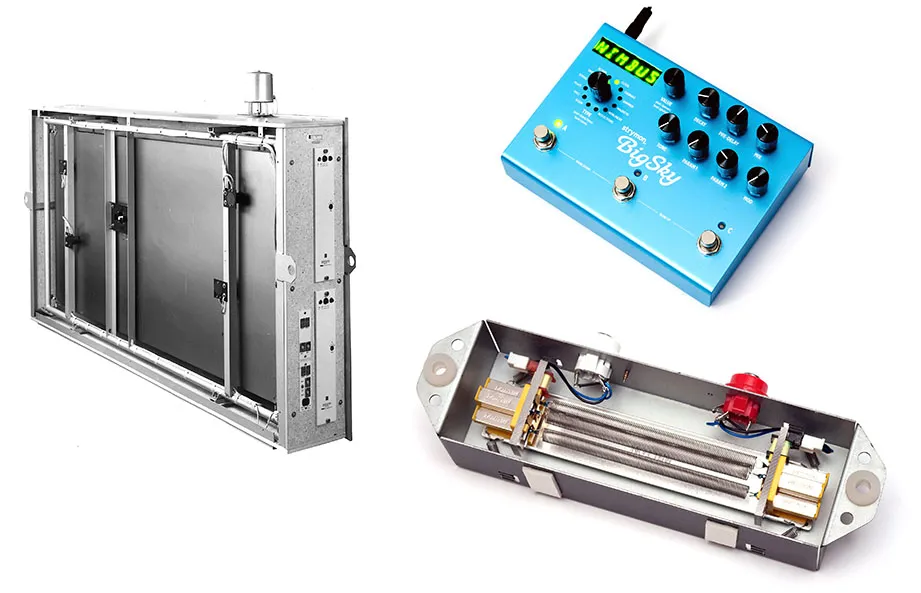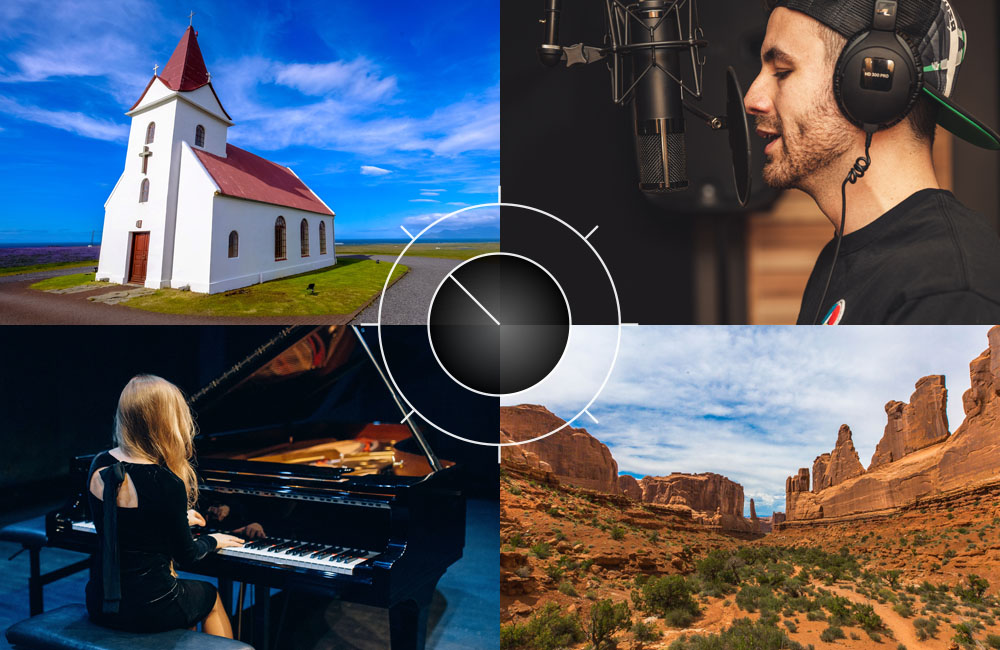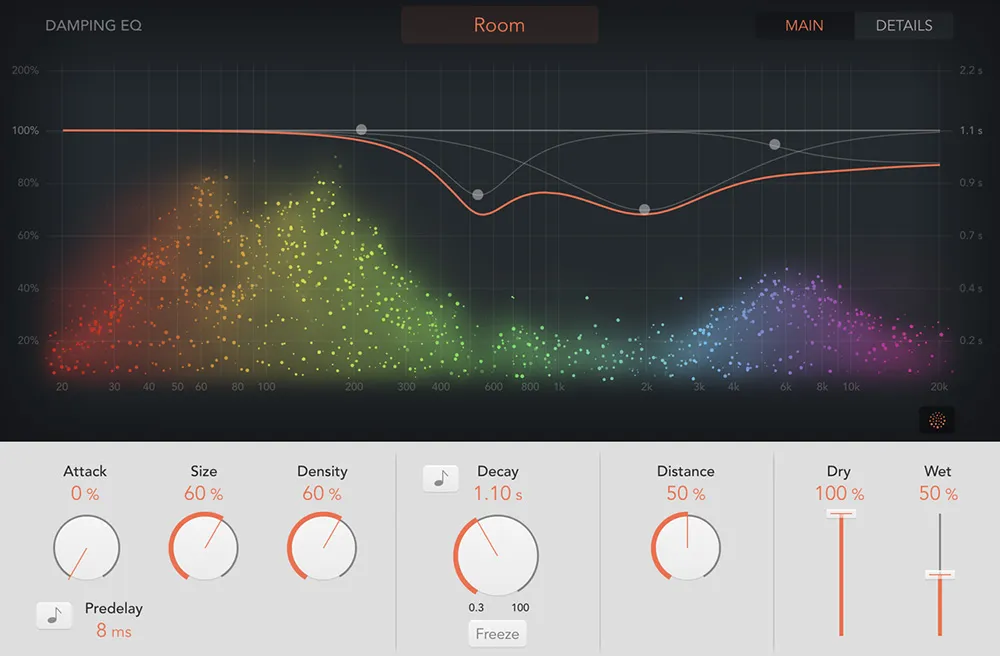
Acoustic waves are always on the move, transmitted by air, water or solids, an ensemble of physical vibrations flowing outwards like ripples on a lake.
Our brain interprets acoustic waves traveling through the air as sound, which may depend on our degree of hearing loss. When sound hits a tightly packed barrier of atoms, like a wall, waves are reflected back in the opposite direction, which is called reverberation. These reflections are more sharply defined when the transmitted sound waves are shorter, for example a speaking voice. In music, the reflections (from hard surfaces) are persistent and varying in frequency, creating an ensemble of ambience.
However, when recording musical instruments, we need to control this array of reflections to enhance frequencies, either designing rooms to reflect sound in a certain way or by using reverb effects plugins, to achieve a desired feel.
The Haunting, Metallic Sound of Plate and Spring Reverb
The earliest sound recordings heard on radio and television were recorded inside an echo chamber, a specially designed room that reflects sound, often with the addition of angled, wooden surfaces to redirect sound waves, adjustable for a desired effect. This is an era long before we redefined an echo chambers as polarised digital media cliques. In contrast to this treated form of reverb, recording studios for pop music, were designed to be totally sound proof, eliminating all natural reverberation. This allowed engineers to reshape recorded sound very precisely using electronic reverb units.
Popular music recordings of the late 1950s and throughout the 1960s used metal plate or spring reverb with a distinctive, metallic sound. Dry, pre-recorded vocals or instruments are filtered through a reverb unit and recorded once again with a microphone.

Artificial Reverb 1950-1980: Plate Reverb, Spring Reverb and 1980s Reverb Pedal.
Any enclosed (or partially enclosed) space is effectively an echo chamber, from your bathroom to an ancient relic or castle, they all reflect sound, but it’s hard to control the reflections to suit a desired ambience without modifying the architecture or hiring an echo chamber (try Twitter). Small adjustments can be made to our homes, perhaps designating a spare room as a makeshift, sound-proofed, music studio. We also need to control the transmission of sound in both directions, eliminating outside street noises and keeping the noise we make inside the room from leaking out. Keeping sound contained within your studio is not just good for healthy next-door neighbour relations, but also helps retain some natural sound reflections (or reverb).
However, there are limitations, we can’t recreate a multi-room studio for different vibes. So we enhance the limited natural reverb with digital effects plugins, to increase ambience.
Simulate Any Space from a Castle to your Bathroom
The main benefits of artificial reverb, whether using a foot pedal or plugin, is economy and endless creative possibilities. You still need to capture sound recordings with good microphones, but the room is less important because we can do lots of post-production by greatly enhancing the music with effects. Instruments or vocals should be recorded reasonably dry, with a little air, then if we want a really wet, airy sound later, we can boost with artificial reverb. There might be occasions when we want natural sound reflections. Led Zeppelin recorded John Bonham’s drum kit at the foot of a stairwell at Headley Grange. Even a bathroom or airing cupboard (as vocal booth) might produce pleasing acoustics. Though sound engineers can recreate lo-fi reverb effects using digital plugins.
In that sense, the process of shaping the ambience of music to your creative needs, combines both physical and artificial techniques.

Alongside recording natural reverb in physical spaces, modern digital reverb effects allows musicians to enhance and simulate any location they can imagine.
Artificial reverb effects are measured in dryness or wetness. For example, lots of reverb wetness would produce the effect of performing in a large church. As you reduce the wetness, thus increasing the dryness, the room (or space) shrinks in size. When mixing music, we imagine a physical space, even though in most cases, we are using artificial reverb. It helps the creative process to imagine where your music is being performed. Sound engineers have varying tastes, some like dryer reverbs, others prefer lots. A very minimal use of reverb is intimate and stark, perhaps suited to solo acoustic guitar singer/songwriters. A good technique for music made with an ensemble of instruments, is to combine both dry and wet. Keep the bass guitar and beats centered and fairly dry, then increase reverb for background pads or string sounds. Employing a contrast of warmth and wetness really colours the final mix and makes the music shine.
Decay of Sound is Easier to Control with Artificial Reverb
A key variable of reverberation is the decay of reflected sound. Decay is the length of time sound reflections linger, measured in milliseconds. Decay is harder to adjust in a natural space because the furniture and fittings are usually fixed and you can’t move the walls further away. Unless of course the room is a specially designed acoustic studio, with adjustable panels. The decay of reverb becomes shorter as you add more objects (and people) to a space. It’s why an empty room is more echoey than the same room full of people, there are more surfaces for sound to absorb into or bounce off.
More often, engineers will adjust the decay setting on their reverb effects unit or plugin, to simulate room size. The decay setting in a digital plugin is a very powerful tool, taking you way beyond what is possible in nature. To such extremes that you can simulate ethereal string sweeps or synthesised choral drone effects.

Apple’s Logic Pro has an excellent built-in reverb tool, with adjustable settings for decay in milliseconds and fine grain control over audio frequencies.
Without reverb effects, recorded music would sound lifeless, whatever the genre. All music needs sparkle added to a mix. There was a trend in the 1970s for recording studios to strip rooms of all ambience entirely, almost sucking the air out completely. Maybe that’s why a lot of 70s rock sounds very smokey and dry. Tighter compression may also create a tense, intimate vibe, particular for drums or bass guitar. As we moved into the 1980s, reverb effects systems were cheaper, pop music sounded big again, this was a return to the days of the haunting, echoey recordings of the early 1960s.
A Few Recommended Reverb Plugins
There are now limitless reverb plugins available on the market. I’ve road tested quite a few and find myself sticking with a couple of good ones. Waves are a brilliant digital effects brand that came to my attention because of their Abbey Road vintage plate and echo chamber emulators. Waves are endorsed by Beatles remixer and producer Giles Martin. FabFilter, an audio effects maker who’s products I’ve used for many years, provide an excellent, modern Pro-R reverb plugin with a vast scope of possibilities that simulates almost any physical space and beyond. There is a Black Hole preset, which ambient drone artists might find useful.
There are creative options in Native Instrument’s spacey plugin Raum, adding crystalline or metallic sound fragments.